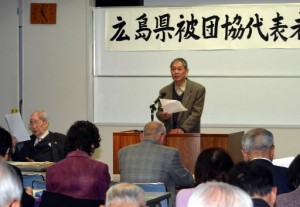Seven groups of A-bomb survivors to pursue joint signature drive in Hiroshima for nuclear abolition
Feb. 2, 2017
by Kyosuke Mizukawa, Staff Writer
On February 1, two groups of A-bomb survivors, both known as the Hiroshima Prefectural Confederation of A-bomb Sufferers Organizations (Hidankyo), announced that the seven A-bomb survivors’ groups in Hiroshima Prefecture would hold a joint signature drive in the city of Hiroshima on March 21. The purpose of the campaign is to gather support from people around the world, including the survivors themselves, to press the international community to conclude a treaty to outlaw and eliminate nuclear weapons. The groups want to strengthen momentum for nuclear abolition prior to the start of negotiations for establishing a treaty that would make nuclear arms illegal, talks that will begin at United Nations headquarters in New York on March 27.
This will be the second joint signature drive, on the city’s streets, for the seven groups of A-bomb survivors. Their first signature drive was carried out last July. This time, the survivors will stand along the Motoyasu Bridge, located near the A-bomb Dome in Naka Ward, to collect signatures.
On the same day, a gathering of representatives for the prefectural Hidankyo group chaired by Sunao Tsuboi was held at the Hiroshima Naka Regional Welfare Center. At this meeting, Koichi Maeda, the group’s secretary general, explained the schedule for the campaign. Kunihiko Sakuma, the chair of the other prefectural Hidankyo group, was a guest speaker. In his speech, Mr. Sakuma stressed that they will work together and make efforts to deliver a powerful message from citizens to the United Nations.
About 100 people, including members from the regional associations of A-bomb survivors, took part in the gathering for representatives. They were also asked for donations to help cover the expenses for the group’s activities. Mr. Tsuboi, the chair of the group, said, “As long as I’m living, I’ll do my best to help realize a peaceful world.”
(Originally published on February 2, 2017)
On February 1, two groups of A-bomb survivors, both known as the Hiroshima Prefectural Confederation of A-bomb Sufferers Organizations (Hidankyo), announced that the seven A-bomb survivors’ groups in Hiroshima Prefecture would hold a joint signature drive in the city of Hiroshima on March 21. The purpose of the campaign is to gather support from people around the world, including the survivors themselves, to press the international community to conclude a treaty to outlaw and eliminate nuclear weapons. The groups want to strengthen momentum for nuclear abolition prior to the start of negotiations for establishing a treaty that would make nuclear arms illegal, talks that will begin at United Nations headquarters in New York on March 27.
This will be the second joint signature drive, on the city’s streets, for the seven groups of A-bomb survivors. Their first signature drive was carried out last July. This time, the survivors will stand along the Motoyasu Bridge, located near the A-bomb Dome in Naka Ward, to collect signatures.
On the same day, a gathering of representatives for the prefectural Hidankyo group chaired by Sunao Tsuboi was held at the Hiroshima Naka Regional Welfare Center. At this meeting, Koichi Maeda, the group’s secretary general, explained the schedule for the campaign. Kunihiko Sakuma, the chair of the other prefectural Hidankyo group, was a guest speaker. In his speech, Mr. Sakuma stressed that they will work together and make efforts to deliver a powerful message from citizens to the United Nations.
About 100 people, including members from the regional associations of A-bomb survivors, took part in the gathering for representatives. They were also asked for donations to help cover the expenses for the group’s activities. Mr. Tsuboi, the chair of the group, said, “As long as I’m living, I’ll do my best to help realize a peaceful world.”
(Originally published on February 2, 2017)








